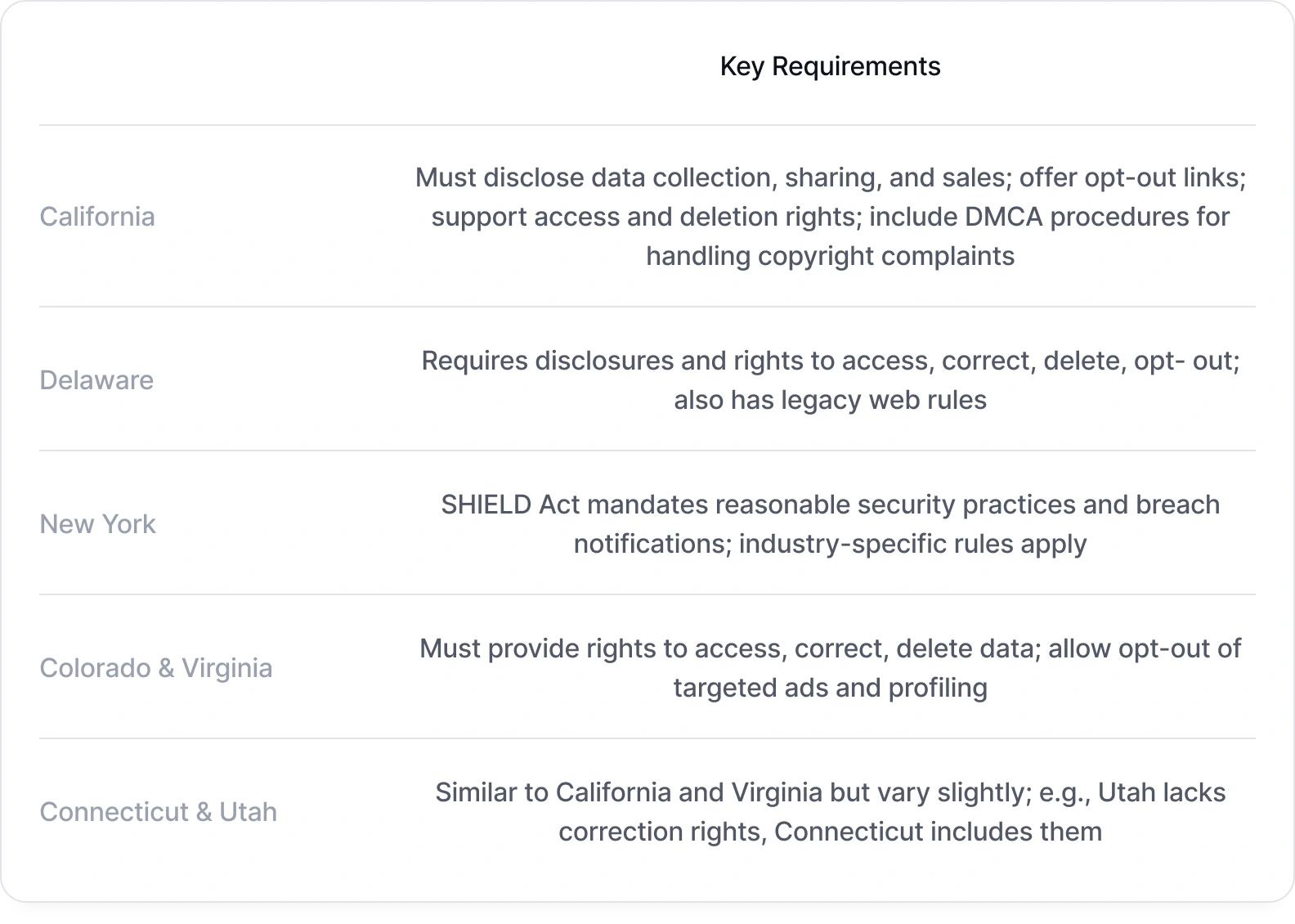
The Legal Anatomy of a Privacy Policy: Mandatory Disclosures for U.S. Businesses
You’re building a product, collecting user emails, tracking behavior, maybe integrating Stripe or Google Analytics. At that stage, a privacy policy isn’t optional. It’s a legal document that outlines what data you collect, how you use it, and what rights your users have under U.S. law. Here’s what that actually means in practice.
Why a Privacy Policy Matters
A privacy policy isn’t just a formality or a checkbox at the bottom of your website. It’s a legal document that explains what personal information your business collects, how you use it, whether you share it, and what rights users have over their data. If you have users, visitors, or customers in the U.S., you undoubtedly need one.
Failing to provide clear and accurate disclosures can open your company to regulatory investigations, lawsuits, or enforcement actions. Even if you’re just starting out, it’s easier to build the right habits from day one than to clean things up later. A good privacy policy also signals transparency and professionalism to your users — two things that are increasingly hard to fake.
What Must Be Disclosed (at Minimum)
U.S. privacy law is fragmented, meaning there isn’t one single federal standard that applies to everyone. But several state laws and general best practices have set a clear baseline. Your privacy policy should include:
- Categories of personal data collected (names, emails, IP addresses, browsing history).
- How you collect it (user input, tracking technologies, third-party integrations).
- Why you collect it (to provide services, personalize content, conduct analytics, marketing).
- Who you share it with (service providers, partners, law enforcement when required).
- What rights users have (access, correction, deletion, opt-out of data sales or tracking).
- How users can exercise their rights (through an online form or contact email).
- Security practices (encryption, restricted access, data minimization).
- Your contact information (for privacy-related inquiries or requests).
Moreover, under the California Consumer Privacy Act (CCPA) and California Civil Code, California residents have specific rights regarding their personal information. These include:
- Right to Deletion: Individuals may request that a business delete personal data collected about them. However, the business may retain certain data if required for legal compliance, security, transaction completion, or other exceptions permitted by law.
- Right to Know: Upon request, a business must provide a detailed report covering the previous 12 months that includes:
- Categories of personal information collected;
- Sources of that information;
- Business or commercial purposes for collection;
- Categories of third parties with whom the data was shared;
- Specific pieces of personal information collected.
To act on these rights, individuals must submit a consumer request. Businesses may require confirmation of identity using information already on file, such as name or email address.
So, this is the foundation. Depending on your audience, tools, or industry, you may need more.
State Laws You Can’t Ignore
Even if you’re not based in a certain state, you may still need to comply with its privacy laws if you collect data from its residents. Here’s a snapshot of key requirements by some state:

Keep in mind, state laws are rapidly evolving. If you collect data across multiple states, your privacy policy should reflect the most stringent applicable rules. New legislation is evolving quickly, so your privacy policy should stay dynamic and responsive.
Do You Need Consent?
In the U.S., consent isn’t always mandatory for basic data collection, but there are exceptions:
- If you collect sensitive personal data (like religion, biometric data, or precise geolocation), some states require prior consent.
- Consent is often required if you sell personal data or use it for profiling or targeted advertising.
- Federal laws like COPPA (for children under 13) and HIPAA (health data) have their own consent frameworks.
Don’t assume you’re in the clear just because you don’t show a cookie banner. Know what data you’re collecting and whether your jurisdiction requires consent.
Tools, Plugins, and Third Parties
Using tools like Google Analytics, Meta Pixel, Stripe, Intercom, or HubSpot means you’re passing user data to external providers. Your policy should:
- Identify categories of third-party tools used;
- Describe what type of data is shared and why;
- Disclose if third parties can use the data independently (as data controllers);
- Include links to their own privacy policies if appropriate.
If you use cookies or similar technologies, it’s a good idea to link to a separate cookie policy or explain these technologies within your main policy.
Best Practices That Go Beyond the Minimum
Good privacy policies aren’t just legally compliant — they’re user-friendly and evolve with your business. Here’s how to strengthen yours:
- Display it prominently. Don’t bury your policy in the footer. Make sure it’s accessible during sign-up and account creation flows.
- Include a cookie and tracking section. Explain what technologies you use, what they track, and whether users can opt out.
- Log and timestamp updates. Note when the policy was last updated. If changes are significant, notify your users.
- Audit regularly. Whenever you add new tools, expand to new states, or launch new features, revisit the policy.
- Document your process. Internally keep track of how data is collected and used so you can respond quickly to user requests.cor













